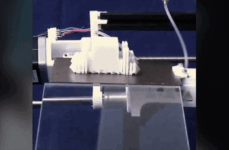
The Robot That Walked Off the Printer – 3DPrint.com
In the Soft Systems Group at the University of Edinburgh, researchers 3D printed a tiny soft robot, then watched as it walked straight off the machine that made it.
This is supposedly the first real-world example of a soft robot that prints itself, stands up, and takes its first steps without assembly or electronics. Built entirely from one ultra-flexible plastic and powered by simple air pressure, this robot may be small, but it could help bring soft robotics out of the lab and into everyday life.

Scientists have created the first soft robots that can walk straight out of the machines that make them. Image courtesy of the University of Edinburgh.
From Printer to Walker
The robot, which looks a bit like a plastic bug and fits in the palm of your hand, was created using a new kind of 3D printer called the Flex Printer. Unlike traditional machines that require complex wiring, sensors, and motors to get moving, this one relies on air.
After the robot is printed, it only needs to be connected to an air supply. When pressure is applied, its soft legs begin to move, and it walks on its own off the machine that made it: no screws, no wires, no batteries.
It’s said to be the first time a device made using space-saving, upside-down, desktop 3D printing has come to life without the need for assembly or electronics, and then walked away under its own power, marking a major milestone for the field of soft robotics.

The Flex Printer allows creating entirely new types of soft systems. Image courtesy of the University of Edinburgh.
What’s Soft Robotics?
Soft robotics is a fast-growing area of science where machines are made from flexible materials, not rigid metal or plastic. These soft robots are squishy, bendable, and more like living creatures than traditional robots. They’re ideal for delicate tasks, like handling fragile objects, exploring dangerous environments, or even moving through the human body for medical purposes.
But there’s been a big roadblock: soft robots are difficult to make. According to the University of Edinburgh team, the field of soft robotics has long been held back by a lack of standard tools and materials. Building these machines usually requires expensive lab equipment, customized printers, tricky materials that are hard to handle, and expert know-how just to get a basic design working. These barriers have made it hard for the technology to expand beyond research labs.
A recent open-access paper published in Device, titled “A Standardized Platform for Translational Advances in Fluidic Soft Systems,” outlines how the team tackled these challenges head-on with the Flex Printer.
“It used to take years to figure out how to print using these materials. Using our new platform, anyone can now easily print things which were previously thought to be impossible,” said Maks Gepner, one of the lead engineers behind the project and a PhD student at the Centre for Doctoral Training in Robotics and Autonomous Systems. “This is a game-changer for engineers and artists alike. Our hope is that this technology will help drive the next wave of research breakthroughs. Without the long-standing manufacturing and design bottlenecks holding it back, we believe soft robotics is ready to make a major real-world impact.”
A Game-Changer for Makers
The Flex Printer is a desktop-sized 3D printer that anyone can build for under £400 (about $500) using off-the-shelf parts. It doesn’t need high-end materials and can be assembled on a desktop without a cleanroom or advanced training. What makes it special is how it handles ultra-soft plastic, especially TPU (thermoplastic polyurethane), a material difficult to print due to its flexibility.
In their published article, the researchers explain that printing with ultra-flexible materials is tricky: “One of the biggest problems associated with printing flexible materials is that the column of ultra-flexible filament easily buckles under compressive load, i.e., when pushed through the heated nozzle. Trying to extrude too fast or with jerky movements results in inconsistent extrusion or even excess buildup in pressure, which can cause jamming of the filament in the extrusion system or even tangling around the extruder gear, requiring tedious disassembly to fix the fault.”
To get around these issues, the Edinburgh flipped the entire printing process upside down. This change made a huge difference. Gravity, instead of causing sagging and print errors, now helps hold structures in place. They could suddenly print airtight, stretchable membranes and tiny air channels, perfect for building soft robots powered by air.
They also introduced “aero supports,” thin, easy-to-remove columns that let them print complex shapes in midair and come off easily after printing, leaving behind clean, functioning robot parts.
One Material, One Print, One Robot
The entire robot is printed in one go using a single type of flexible plastic. Inside, it has air-powered components, which the researchers call “fluidic logic,” built directly into the structure. At its core is a pneumatic ring oscillator that sends out pulses of air pressure, coordinating the robot’s movement without any electronics.
Once printing is done, a pressure hose is connected. The robot hangs from the upside-down printer bed, which then flips upright. With the press of a button, air flows in, and the robot starts walking. A video shows it taking slow, rhythmic steps off the bed.
This breakthrough isn’t just about making tiny robots walk. It’s about removing barriers. The team hopes their Flex Printer will “democratize” soft robotics, making it accessible to students, researchers, artists, and engineers around the world.
By doing so, the researchers hope to unlock innovations across various fields. In medicine, soft robots could one day navigate inside the human body. In space, they could be printed and deployed directly in orbit. And in hazardous environments, like nuclear sites or explosive zones, these robots offer a safer alternative, since they don’t rely on electronics or produce sparks.
Even better, the robots are recyclable. They’re made from one material and can be melted down and reprinted into new shapes.
Join the Movement
The Edinburgh team has published their designs and code online, encouraging others to improve and adapt the system. They’ve even launched a “bestiary” of 3D printable robot parts for building soft machines. They hope that more people will build these robots, tweak the designs, and maybe one day use them in everyday life.
For the team, that first robot to step off the printer and into the world carries with it the promise of a more flexible, accessible future for robotics.
Subscribe to Our Email Newsletter
Stay up-to-date on all the latest news from the 3D printing industry and receive information and offers from third party vendors.









